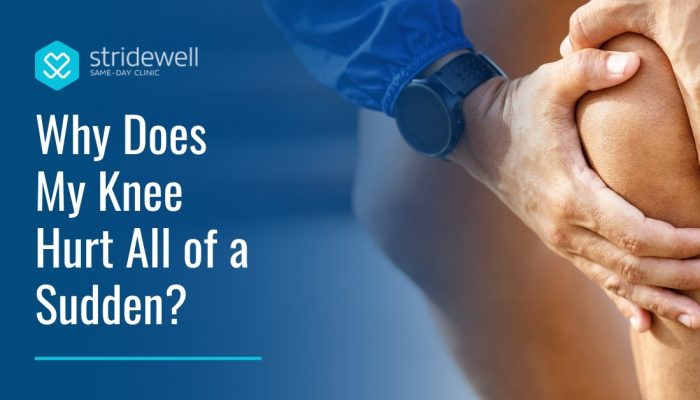Knowing how to identify knee pain is critical. These routine actions, such as bending and standing for an extended amount of time and walking, are the most common contributors to knee pain. Running or participating in sports that entail a lot of jumping or fast pivots can also lead to knee pain in athletes.
As we become older or get injured, our knees may become more prone to pain and discomfort.
Read further to answer your question, “why does my knee hurt all of a sudden?”.
Common Knee Problems
The knee is a complex joint that is prone to a wide range of ailments. There are several frequent knee injuries, including femoral and patellar ligament tears.
Bracing and rehabilitation are two simple procedures that can be used to treat knee problems. Surgery may be required to restore complete function to some orthopedic injuries.
Knee Sprain
Tear in the knee ligaments are known as knee sprains. The knee is supported and aligned by a large number of ligaments. It is the ACL and PCL that act as a stabilizing force in forward and backward knee movement. They meet in the middle of your knee joint. The medial collateral ligament (MCL) and lateral collateral ligament (LCL) function together to keep the knee stable.
Knee Fracture
Fractures of the kneecap (patella), femur, or tibia near the knee joint are examples of knee fractures. Depending on the severity of the fracture, it might range from a single crack to many pieces. Falls, automobile accidents, and sports injuries are all common causes of knee fractures.
Knee Bursitis
An injury called bursitis of the knee occurs when a small fluid-filled sac (bursa) around the knee joint becomes inflamed. There are bursae, which act as a buffer between the bones in your joints, as well as the muscles and skin that surround them.
Inflamed knee bursitis can affect any bursa in your knee, but it’s most common above the kneecap or below it.
Bursitis in the knee is a painful condition that may limit one’s ability to walk. A mix of self-care and physician-administered medications are typically used to treat knee bursitis.
Knee Joint Dislocation
Thighbone and shinbone misalignment at the knee joint causes a dislocated knee. Leg trauma, such as a fall, sports injury, or vehicle accident, can cause it. However, you must know that a dislocated knee is different from a dislocated kneecap.
Meniscus Tear
A typical cause of meniscus tears in volleyball is jumping or twisting. Football and soccer players frequently change direction while sprinting, are more prone to meniscus tears than other athletics. The meniscus can be torn in any way that the knee is twisted, cut, or rotated. Meniscus tears can occur as a result of normal wear and tear.
Arthritis
Osteoarthritis of the knee is the most common form of the disease. It is a degenerative disorder in which the cartilage in joints gradually wears away over time. People in their forties and fifties are particularly vulnerable.
Many factors might lead to the development of osteoarthritis, such as repeated joint trauma or obesity. Additionally, rheumatoid arthritis can cause knee inflammation and knee cartilage damage. In comparison to osteoarthritis, rheumatoid arthritis is more common in younger people.
Frequently Asked Questions
What is the right time to see a doctor?
Each person has a different pain threshold. Consult a physician if you have suffered an injury and your knee swells. Even if the swelling reduces, you should have your knee analyzed due to the possibility that you strained something within the joint.
If you have arthritic pain and have more bad days than good days, you should contact a physician to undergo a general evaluation.
How can you diagnose a knee injury?
Consulting a physician is recommended to aid in pain management. Along with a thorough medical history and physical examination, further tests for knee problems may include the following:
X-ray
An X-ray of the knee can aid in detecting the cause of common knee signs and symptoms such as pain, discomfort, swelling, or deformity. It can identify broken bones and dislocated joints. After setting a broken bone, the image can be utilized to determine whether the bone is aligned correctly and has adequately healed.
Magnetic resonance imaging (MRI)
Using strong magnets, radiofrequency, and a computer, this test creates detailed images of organs and structures within the body; it frequently detects damage or disease in a surrounding ligament or muscle.
Computed tomography scan (also called a CT or CAT scan)
CT scans produce more detailed images than ordinary X-rays.
This test uses X-rays and computer technologies to create horizontal, or axial, images (often referred to as slices) of the body. A CT scan generates detailed images of any part of the body, including the bones, muscles, fat, and organs.
Arthroscopy
Arthroscopy is a minimally invasive diagnostic and therapeutic method for joint problems. This treatment uses a small, illuminated optic tube (arthroscope) that is introduced into the joint via a small incision.
A screen is used to project images of the inside of the joint; these images are utilized to analyze any degenerative or arthritic changes in the joint, detect bone illnesses and tumors, and determine the reason for bone pain and inflammation.
Radionuclide bone scan
A nuclear imaging procedure involves injecting a trace amount of radioactive material into a patient’s bloodstream to be detected by a scanner. This test measures blood flow to and activity of cells within the bone.
Call Stridewell and learn why your knee hurt all of a sudden
If you had a previous knee injury that was not adequately managed, it may flare up sometimes or cause constant pain. It is crucial to seek advice and assistance from a reliable pain management clinic. Contact Stridewell today.
read article


